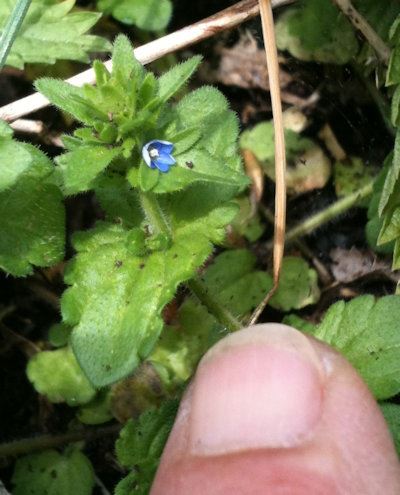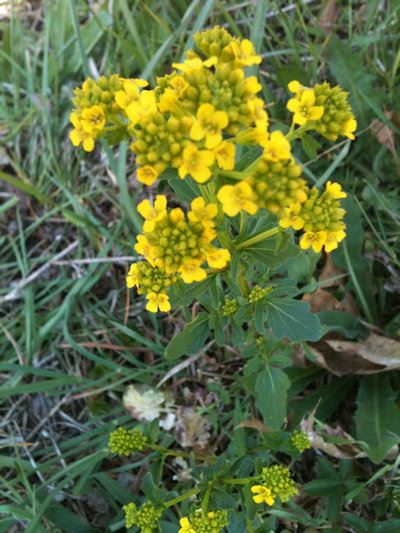
Ground ivy (Glechoma hederacea)
Ground ivy carpets the ground with flowers. We adore the flowering
tops in our salads.

Narrow leaf plantain (Plantago lanceolata)
Plantain holds its flowers atop long stiff stems. The whole affair reminds me of a flying saucer. Anytime is a fine time to harvest leaves for salads (chop finely) or infused oil.

Common speedwell (Veronica officinalis)
This was once a favored remedy for those with respiratory It is edible, but too bitter and too tiny to be worth foraging for salad.

Corn speedwell (Veronica arvensis)
This speedwell is even smaller than her official sister.

Celandine poppy (Cheladonium majus)
She is showing off her stunning, abundant yellow flowers. Not to be confused with mustard family plants, though they do have four petals. The yellow sap of this poisonous plant can be used against skin cancer.


Yellow rocket or Barbara's cress (Barbarea vulgaris)
Our winter friend, now brings the sunlight to earth as she spreads her yellow cheer. The leaves are now too bitter for my taste, but I do like the flowers and flower buds in my salads. Note the four-petaled mustard family flowers. Both the "H" and the "X" pattern of the four petals are visible in this close-up photo.
Mint Honeys
by Susun Weed
Mint honeys are a delicious way to prevent and treat winter miseries: the flu, colds, and coughs especially.
I usually make mine just before the frost takes down the tender mints, but January is not too late to get some started if you have access to hardy mints. Overwintering rosemary, sage, thyme, and lavender appreciate a haircut about now, for lush spring growth.
Outdoor hardy mints are best harvested on a warm sunny day with care not to steal too much from the plants; leave them enough to get through the coming cold days.
To make your honey:
- Fill a jar with your hardy mint, best if you cut it fairly fine.
- Pour real honey over the herb in the jar. No need to use raw honey; since you will be using these herbal honeys to make tea with boiling water, it won't be raw after you brew it up. See if you can buy local honey. One of the ways to counter colony collapse in the beehives is to encourage more small scale beekeepers. The best way to encourage them is to buy their honey. (Smile) You may wish to view Vanishing of the Bees, an interesting look at colony collapse by Ellen Page.
- After you have filled your jar with fresh herb and honey, put a tight lid and a label on it. Then the hard part: Wait for six or more weeks.
Once your hardy mint honey is ready (in about 4 weeks), you need only scoop a large spoonful of the herb and honey into a cup, fill with boiling water and drink. Wow! Instant herb tea.
Yes, you can eat the honeyed herbs in your tea cup if you want to, or just add them to your compost pile when you have finished your tea. (The leaves tend to fall to the bottom of the cup.)

 The Wise Woman Center exists to re-weave the healing cloak of the Ancients. This land is sacred, it is a safe space for women, and a place for the teachings of the Wise Woman way. The Goddess lives here, as do goats, fairies, green witches, and elders.
The Wise Woman Center exists to re-weave the healing cloak of the Ancients. This land is sacred, it is a safe space for women, and a place for the teachings of the Wise Woman way. The Goddess lives here, as do goats, fairies, green witches, and elders.







